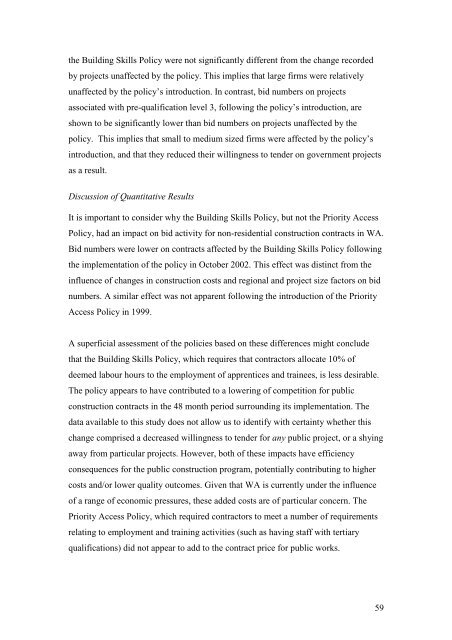Multi Outcome Construction Policy (final report)
Multi Outcome Construction Policy (final report)
Multi Outcome Construction Policy (final report)
Create successful ePaper yourself
Turn your PDF publications into a flip-book with our unique Google optimized e-Paper software.
the Building Skills <strong>Policy</strong> were not significantly different from the change recordedby projects unaffected by the policy. This implies that large firms were relativelyunaffected by the policy’s introduction. In contrast, bid numbers on projectsassociated with pre-qualification level 3, following the policy’s introduction, areshown to be significantly lower than bid numbers on projects unaffected by thepolicy. This implies that small to medium sized firms were affected by the policy’sintroduction, and that they reduced their willingness to tender on government projectsas a result.Discussion of Quantitative ResultsIt is important to consider why the Building Skills <strong>Policy</strong>, but not the Priority Access<strong>Policy</strong>, had an impact on bid activity for non-residential construction contracts in WA.Bid numbers were lower on contracts affected by the Building Skills <strong>Policy</strong> followingthe implementation of the policy in October 2002. This effect was distinct from theinfluence of changes in construction costs and regional and project size factors on bidnumbers. A similar effect was not apparent following the introduction of the PriorityAccess <strong>Policy</strong> in 1999.A superficial assessment of the policies based on these differences might concludethat the Building Skills <strong>Policy</strong>, which requires that contractors allocate 10% ofdeemed labour hours to the employment of apprentices and trainees, is less desirable.The policy appears to have contributed to a lowering of competition for publicconstruction contracts in the 48 month period surrounding its implementation. Thedata available to this study does not allow us to identify with certainty whether thischange comprised a decreased willingness to tender for any public project, or a shyingaway from particular projects. However, both of these impacts have efficiencyconsequences for the public construction program, potentially contributing to highercosts and/or lower quality outcomes. Given that WA is currently under the influenceof a range of economic pressures, these added costs are of particular concern. ThePriority Access <strong>Policy</strong>, which required contractors to meet a number of requirementsrelating to employment and training activities (such as having staff with tertiaryqualifications) did not appear to add to the contract price for public works.59
















